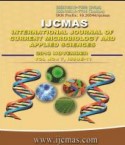


 National Academy of Agricultural Sciences (NAAS)
National Academy of Agricultural Sciences (NAAS)

|
PRINT ISSN : 2319-7692
Online ISSN : 2319-7706 Issues : 12 per year Publisher : Excellent Publishers Email : editorijcmas@gmail.com / submit@ijcmas.com Editor-in-chief: Dr.M.Prakash Index Copernicus ICV 2018: 95.39 NAAS RATING 2020: 5.38 |
Present study included twenty-four dogs affected with Canine Transmissible Venereal Tumour (TVT). affected dogs were divided equally into three groups viz. vincristine therapy (Group I) with 7 day cycle and doxorubicin therapy consisting two groups i.e. Group II with 14 day cycle and group III with 21 day cycle and was aimed at diagnosing transmissible venereal tumour (TVT) initially using most common clinical signs and confirmation made by histopathological examination of biopsy tissue. Diagnosis based on clinical signs in all TVT affected dogs presented in teaching veterinary clinical complex (TVCC), Hisar revealed that continuous bloody discharge, excessive licking of genitalia, tumour growth were consistent in all affected dogs (100%). Histopathology of affected dogs done before treatment revealed that tumour consisted of loose sheets of round polyhedral cells. These cells had large round top pleomorphic nucleus having prominent centrally placed nucleoli along with frequent mitotic figures and a few new blood vessels.
 |
 |
 |
 |
 |